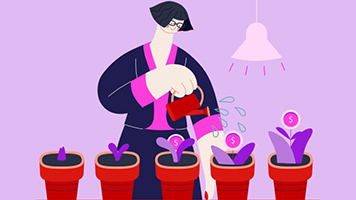Here are some key factors that could help ensure your investment proves to be a good one.
Capital growth
Capital growth is basically the increase in the value of the property over time. Look into the growth-trend indicators for the property you’re thinking of investing in – what’s the median sale price for the suburb? Has it increased over the past few years?
Our property market research tool is a good way to get a sense of capital growth in areas you’re looking at. It provides a comprehensive overview of properties and suburb trends across Australia, including past sales in the area, demographic information, nearby schools and median rental income.
This information could help you build a picture of what your capital gains (ie: how much you gain financially based on the capital growth of the property) may look like over time.
Rental demand and yield
Investors often plan on renting out their property to generate income and help cover costs. Researching areas with strong rental demand and yield is an important part of assessing the financial viability of an investment property.
Rental yield is a calculation of how profitable a property can be, based on the expected rental income balanced against the costs of owning and maintaining the property. These include mortgage repayments, strata fees, council fees, maintenance and insurance. Ideally, you should have a steady, reliable rental income that goes some way towards covering these costs.
Looking into the performance history of other similar properties, including vacancy rates, average rental yield, median weekly rent and its potential growth rate, plus what types of property are in demand with tenants, may help with these calculations.
Rental yield can be calculated in gross and net terms. Gross rental yield is the total value of the property divided by the expected annual rent, multiplied by 100 to get a percentage.
For example, an investment property worth $500,000 with expected rental income of $500 per week gives you the gross rental yield of:
$26,000 ($500 x 52) / $500,000 = 0.052 x 100 = 5.2%
Net rental yield is slightly more complex, as it factors in all your costs and fees, such as council rates, strata levies, property management fees, depreciation and insurance.
Using the same example above, assume the total annual costs to maintain the property are:
- $1200 council ($300 per quarter * 4)
- $2000 strata ($500 per quarter * 4)
- $520 property rental fee
- $1200 property insurance
(total of $4,920)
The net rental yield of the property would be:
$26,000 ($500 x52) – $4,920 / $500,000 = 0.042 x 100 = 4.2%
It’s worth noting that this figure doesn’t include your home loan repayments, as that depends on individual situations (our repayment calculator can help you estimate this). Also the above calculation is just an example and not based on actual costs to maintain a property. Costs and calculations may vary depending on your personal circumstances.
Location
Location, location, location – it’s a real estate cliché for a reason and it’s just as valid for investors as the people who live in the property. Put yourself in a prospective tenant’s shoes and think about what they will be looking for in a rental. Proximity and convenient access to public transport, schools and other amenities that are part of most people’s lifestyles, such as shops and restaurants, will make the property more appealing to a tenant.
In more general terms, a neighbourhood’s safety and general vibe are both important factors when figuring out its growth potential. For example, if the area is likely to undergo development that will bring more shops and cafes or there are big infrastructure projects that could mean more local jobs, these things may increase the attractiveness of the property’s location as well as its value.
Type of property
While the decision on whether to invest in a house or a unit will be largely determined by your budget, you should think about the type of property in the context of location too.
For example, a house with a backyard will likely be more appealing to tenants in a family-friendly suburb, rather than a compact apartment. Similarly, a modern apartment may see higher rental demand in areas near universities, where there’s usually a high volume of students looking to rent. It’s really important to understand the demographics of the area and choose accordingly.
Houses are generally more expensive to buy and insure, and can require more maintenance, but equally, they can fetch higher rents on average and have higher capital growth. On the flip side, units generally start at a lower price point and require less maintenance, but there can be other costs such as strata fees to think about.
In fact, strata fees are just one of a list of ongoing maintenance costs, which you also need to think about when it comes to deciding whether to invest in a house or apartment.
Age of the property
This is an important factor that can have an effect on the cost equation. Investment properties typically involve ongoing expenses, so you want to make sure you don’t buy a property that is a drain on your finances through maintenance costs.
Older properties might need more maintenance, but it all depends on the condition they’re in – be sure to check everything, from the structure to fittings and fixtures. Make sure you get professional building and pest inspections done before you commit to a contract of sale.
You may be up for the challenge of renovating a property that needs minor fix-ups, if you’ve factored that into your budget. But if it needs major renovations, then it might not end up being a profitable investment.
Another way in which the age of the property will affect your finances is the property’s depreciation schedule.
Depreciation on investment property is a calculation of how much the value of the property and its contents - including white goods, carpet etc. – will decrease over time, based on which you may be able to claim as tax deductions¹.
Property features
Even though you may not be planning to live in this property, someone will be. So think about the things that people usually look for. Features like a garage, additional bathrooms, or a home office space will go a long way in increasing the property’s rental value. The layout and design of the property make a difference too. Is it designed with practical everyday living in mind? Does it have natural light? These are all things tenants are often looking for, so you should too, before you buy.
As you may be able to tell, most of these factors relate to each other – the location and age of the property will have an effect on its capital growth, for instance – so you should think about all of these factors in a holistic way before making a decision.
Do your research and once you are ready to become an investor, find out more about our current investor home loan rates and request a call back to talk to your own dedicated Home Finance Manager.




